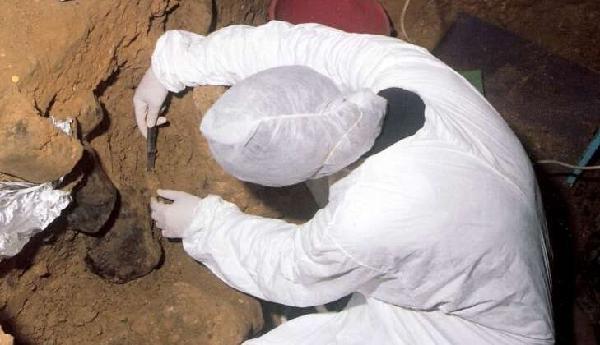(单词翻译:单击)
听力文本
This is Scientific American — 60-Second Science. I'm Christopher Intagliata.
Fossilized skulls and skeletons found in European caves gave us our first glimpse of our ancient cousins, the Neandertals. And a finger bone, found in a Siberian cave, first indicated the existence of another relative—the Denisovans. But fossils are hard to come by. So here's another option: analyze cave floors to see if they contain any DNA.
"We find ancient hominins, we find Neandertal mitochondrial DNA, and Denisovan mitochondrial DNA."
Viviane Slon, a geneticist at the Max Planck Institute in Germany.
She and her team found that molecular evidence by testing teaspoonfuls of sediment from seven different caves. And they screened specifically for mitochondrial DNA—because there's a lot more copies of it in cells compared to nucleus DNA, which has just one set per cell.

The researchers uncovered genetic evidence of Denisovans where you might expect—at Denisova Cave in Siberia. Which showed that their strategy was sound. They found Neandertal DNA there too, and at three of the other seven caves—including a cave where no Neandertal fossils have ever been found, only artifacts and animal bones. And they found the DNA of some surprise guests, too: "For example, the woolly mammoth, or the woolly rhino. We have cave hyenas and cave bears." The study is in the journal Science.
This preliminary success, Slon says, means the method could be a good complement to traditional surveys. "We're not trying to replace working on ancient DNA from fossils, but rather open all the archaeological sites where there are no hominid fossils for genetic analyses." Leading, hopefully, to a broader census of our ancient relatives. No bones about it.
Thanks for listening for Scientific American — 60-Second Science Science. I'm Christopher Intagliata.
参考译文
这里是科学美国人——60秒科学。我是克里斯托弗·因塔利亚塔。
在欧洲洞穴发现的化石头骨和骨骼使我们首次了解了我们的远古表亲——尼安德特人。另外,在西伯利亚一个洞穴发现的手指骨,则首次证实了我们另一个亲属丹尼索亚人的存在。但是化石很难获得。还有一个方法:分析洞穴地面成分,看看其中是否含有DNA。
“我们发现了古人类的痕迹,发现了尼安德特人和丹尼索瓦人的线粒体DNA。”
维维亚娜·斯隆是德国马克斯普朗克研究所的遗传学家。
她和她的团队在检测了来自7个洞穴的几茶匙沉积物后发现了分子证据。他们专门筛选出了线粒体DNA,因为这种DNA在每个细胞中有许多份,而细胞核DNA只有一个。
在你可能预料到的地方——西伯利亚的丹尼索瓦洞穴,研究人员发现了丹尼索瓦人的基因证据。这表明他们的策略是正确的。研究人员在那里也发现了尼安德特人的DNA,而在其他7个洞穴中的3个洞穴中,有1个洞穴没有发现尼安德特人化石,只有一些人工制品和兽骨。他们还发现了一些意外来客的DNA:“比如猛犸象或披毛犀,还有洞鬣狗和洞熊”。这一研究结果发表在《科学》期刊上。
斯隆表示,研究的初步成功意味着这种方法能成为传统调查的良好补充。“我们并不是要取代对化石中古代DNA的研究,而是要揭开所有考古遗址的秘密,因为这些考古遗址没有供基因分析的古人类化石。”希望这能为我们的古代亲戚做一个更广泛的人口普查。而且要毫无疑问。
谢谢大家收听科学美国人——60秒科学。我是克里斯托弗·因塔利亚塔。
译文为可可英语翻译,未经授权请勿转载!
重点讲解
重点讲解:
1. come by 弄到;得到;
例句:In rural France, English language magazines are rather hard to come by.
在法国乡村,很难找到英语杂志。
2. compared to 与…相比;和…比起来;
例句:Ferries are very powerful and manoeuvrable compared to cargo ships.
与货船相比,渡船马力大而且易操纵。
3. for example 例如;比如;
例句:For example, a research paper could be made into a video but would not be as easy to follow as the text.
比如,一份研究论文可以制作成视频,但不如文本易于理解。


